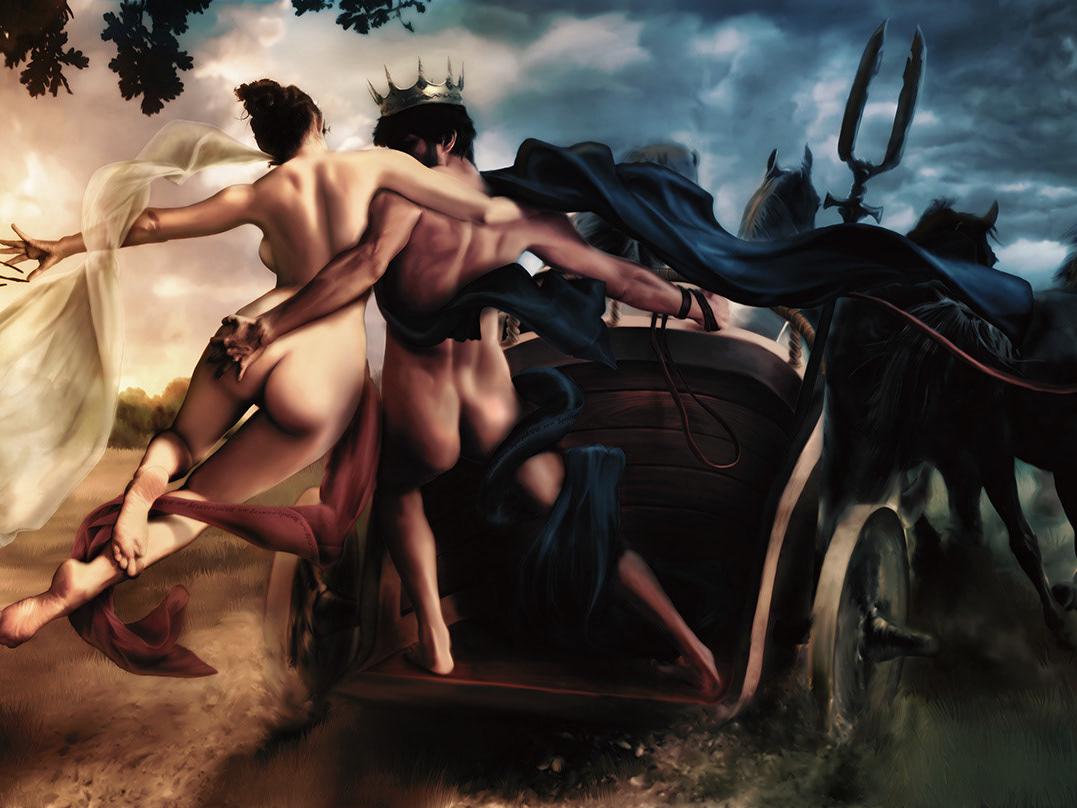Pygmalion and Galatea
Artistic Nude Photography
3D Modeling and Rendering
Photo composition
Photo Editing
Digital Painting


My final piece at left, and the original inspiration at right.
Allow me to share with you a history about art and love. Is a history about a journey through , Greek mythology, art history, creation techniques, female beauty, and love standards. I´m pretty sure you will like it. So, enjoy!
All began some years ago, when I came to New York and had the opportunity to meet the Metropolitan Museum of Art. Among that astonishing infinity of wonders, I remember that one piece called my attention in a special way, and made me stand there looking at that masterpiece for a long time ❤️.
By that time I didn't know the piece nor the artist, nor what exactly had attracted me so much, but that painting was beautiful, and something told me that there were many deep meanings to be discovered. It was “Pygmalion and Galatea”, a work from the French artist Jean-Leon Gerome, made in 1890.
The work is Inspired in an ancient narrative recounted in Ovid’s Metamorphoses, which tells the tale of Pygmalion, king of Cyprus, sculptor and a solitary bachelor who was not able to find a true love. Drowned in sorrow, he decided to sculpt with his own hands what would be the perfect woman for him. Embarrassingly, he truly fell in love with that sculpture, and named her “Galatea”. However, his work only increased his suffering, once that beautiful piece of stone would never be able to love him back. Tired of his sadness, he prayed to the goddess Venus (Aphrodite) for a woman like his ivory sculpture Galatea. The goddess heard him, and when he came back to his workshop, he went upstairs to give his beloved statue a kiss, as he always did, but this time the kiss was returned, not from the usual cold ivory, but from sweet and warm lips. Venus has made his sculpture come to life! The painting work from Gerome shows this very powerful moment when the sculpture starts transforming from ivory to flesh, and comes to life, taking his beloved creator in her arms, surprising him.
Pygmalion and Galatea - Jean geromJean-Léon Gérôme - 1890
BACK TO 3D MODELING
Recently I felt inspired to come back to produce art by hobby after almost four years without touching any drawing tool. My idea was to practice some of my beloved art skills (3D modeling, Digital Painting, Drawing, Photography and Photo Editing) and try to combine all these techniques in a single piece. I let the inspiration flow and the masterpiece of Pygmalion and Galatea came to my mind. Still without knowing all the deep meanings in this masterpiece, I started to work.
This was the plan: recreate Gerome´s scenario using 3D modeling, then produce a real photograph representing Pygmalion and Galatea, then finally combine all the elements using Photo edition and Digital Painting.
I started by measuring all the elements of the workshop and making a perspective study to find out how I would position each object to recreate the same perspective and composition from Gerome´s scenario. So I´ve started modeling the floor and walls, trying to fit the same result from the original piece, then I´ve made the bench in the back side of the room, the wood stair, the wood boxes, and the wood base where the sculpture would be standing. Then I´ve created the camera and positioned it in a way that would give me the same perspective composition from the original painting. I found out that Gerome has of course made an awesome work on the perspective technique, with all the great precision that this technique allows an artist to recreate the illusion of volume and depth. But I also found out that Gerome made some mistakes when trying to reproduce the perspective of the woodboxes on the floor. Ok, you may be thinking who am I to point out mistakes in a masterpiece 😋. Well, I´m just a regular guy using a computer which calculates perspective, light bounces, and simulates all the physics behaviours with highly complex algorithms running in real time, c´mon 😅.





ENVIRONMENT LIGHTS AND TEXTURES
After the main elements are in the scene, I´ve started researching ambient lighting. Once again I was amazed with the technical precision from Gerome. Once I figured out the light sources that Gerome considered in his work, I just positioned the 3D light spots in the right places and BANG! lights and shadows were there, giving me almost the same results from Gerome´s work.
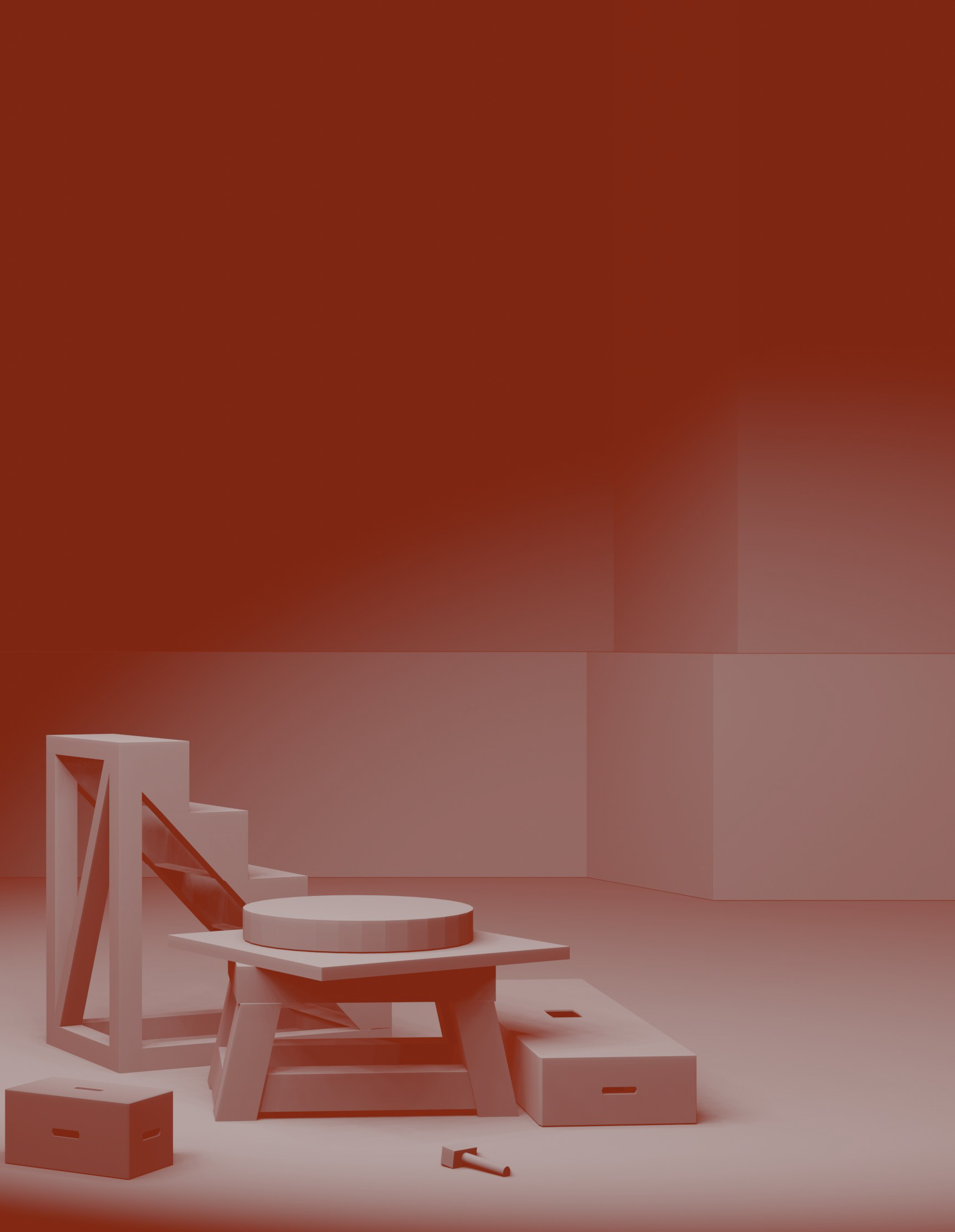



THE MEDUSA SHIELD
To make the other scene elements, I challenged myself to try 3D organic sculpting for the first time. I have a very solid knowledge in technical drawing and 3D modeling, which makes me very good at modeling 3D things like mechanical parts, architectural and engineering projects, but 3D modeling is totally different from 3D organic sculpting, and this is a totally new field to me. 3D modeling relies on geometry and precise calculations, while sculpting requires a more artistic and manual approach. So, you will notice that my result is not very good in the sculpting part, but you will also see my efforts! At least I´ve learned so much and had real fun doing this 😊.
So I´ve started by sculpting the golden shield, and really struggled to make that ugly face placed in the center, since I was using the sculpting tools for the first time. However, once the original is already ugly by default, we can assume that my result was not so bad haha😅. After sculpting, I´ve applied the bronze texture and tried to achieve some rusty scratches.
While sculpting, I started to think about the meaning of that shield. After some research, I found out that this may be a Medusa Shield, or Aegis, a representation of the shield of Athena which has the head of medusa attached on it, so everyone who looks at the shield would be transformed into stone. I found it very meaningful since the Pygmalion´s tale is about a statue that becomes human, exactly like the opposite effect from Medusa's curse. Another intriguing fact is the true reason why Pygmalion was not able to find love in real women: Some feminist thinkers would judge Pygmalion as a misogynist, because of his aversion to real women, to the point of making his own perfect, idealized and unreal version of woman. This brings us to a very current and ongoing discussion about the oppression of beauty standards and sexism. But going deeper in the history, I found out that Pygmalion was actually very upset because the women from Cyprus (the Propoetides) had rejected the divinity of Venus (goddess of beauty and love) and, because of that, Venus punished them with a curse that caused them to lose their moral and started to practice prostitution in public for mere addiction, with no virtue, no beauty, no love or respect for the men they were having sex, and worse: no love for their own bodies and desires, no respect for themselves.This caused such disgust in Pygmalion that he thought he could never find a virtuous woman to love. So, instead of misogynist, he was just a true devotee of the principles of Venus, which associates love and beauty to sensual desires. What Pygmalion actually hated was the lack of love, beauty and respect from the cursed Propoetides. As part of the curse, it is said that the Propoetides lost the “ability to blush”, so the blood of her faces hardened and turned into stone, making them later turn into full stone statues. Again, very much like the effect from Medusa! The fact Pygmalion has a Medusa Shield in his workshop may be translated as a wish to protect him and his beloved Galatea from the evils of promiscuity. What a deep meaning behind a single shield!
And you? How would you interpret the meaning of the Medusa Shield in this painting?


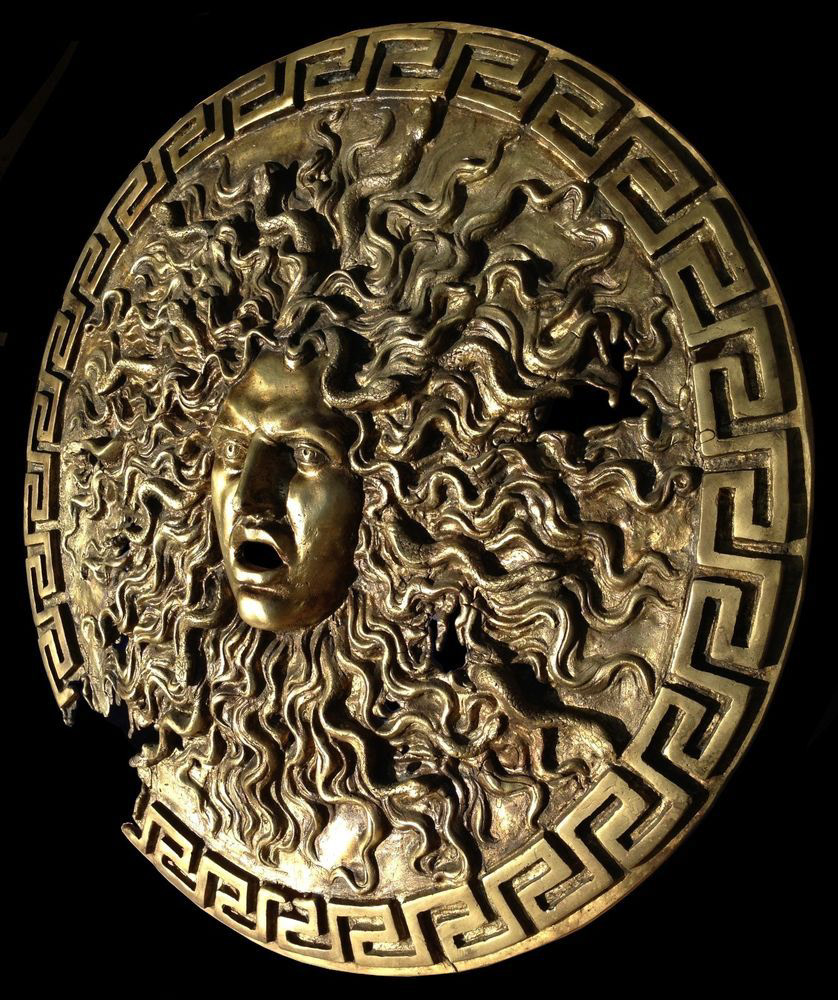





LOOKING AT THE MIRROR
One of the sculptures in the background of Pygmalion and Galatea from Jean-Leon Gerome is a woman sitting and looking at a mirror. It may be related to the women´s recurrent concern about beauty. The sitting position reminds a resting position, like she is tired of the heavy journey which is the search for fitting the beauty standards imposed by the society. But it may also mean just the opposite, like a peaceful moment where the wise woman looks to herself and loves herself for what she truly is.
Once again my sculpting skills did not help very much 😅, but since these sculptures are not so visible my poor job will not be too visible in the final result. The most important here is making the general light and volumes to resemble the original pieces.



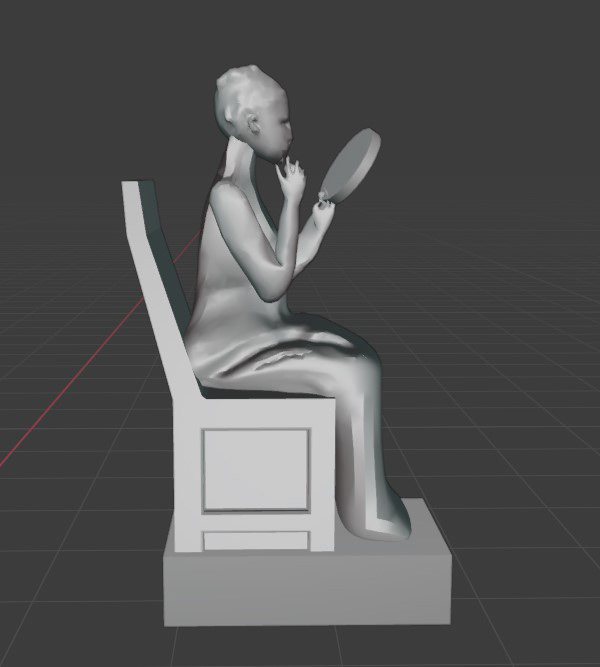

MOTHER AND CHILD
One of the sculptures in the background is a mother with a child, clearly resembling the concept of motherhood. The child is protected between her arms, but also standing in its own feets. I would say this is a great picture of balanced motherhood, that cares and protects, but also gives autonomy, and doesn´t consume the mother's life and energy with the weight of always carrying the child in her arms.





DIANA, THE HUNTRESS GODDESS
The last of the sculptures in the background is a bust of Diana, the goddess of Hunting and Wildlife. Diana is well known for her boldness and courage, and is often considered a kind of triple goddess: Diana as huntress, Diana as the moon, and Diana of the underworld. She is also a midwife goddess that helped mothers in childbirth, and she has a strong relationship with the nymphs. She was always accompanied by nymphs that followed her and helped her in the hunting. To me, her connection with motherhood and beauty creates a direct relationship with the other sculptures which are exactly related to these meanings. Diana is a symbol of the self sufficient woman, strong, independent, deeply connected with nature and with other women (sorority!).
The three sculptures in the background on Gerome's work, added to the triad goddess Diana by itself may represent something like the three virtues of Pygmalion´s ideal women: strength, motherhood, true beauty, and since these elements are placed in Pygmalion's workshop, it may mean these objects were inspirations when conceiving his ideal woman, far beyond the beautiful milky-white body.










THE FISH AND THE NYMPH
As every element may have a meaning, I supposed that the fish couldn´t be different. The fish made me wonder that maybe Galatea would be in some way related to the sea. I know that Greek mythology frequently refers to wonderful sea beings, the Nereids. Nereids are sea nymphs and symbolize everything that is beautiful and kind about the sea. They are represented as very attractive girls, with melodious voices. They were part of Poseidon's entourage and carried his trident. I found out that “Galatea” is also the name of one of the fifty daughters of Nereus, and her name means either "goddess of calm seas" and "milky-white". So I assumed that when Pygmalion conceived his beloved figure, he was probably inspired by the beauty and purity of a sea nymph, and this may be why he has chosen to put a fish at her feet.
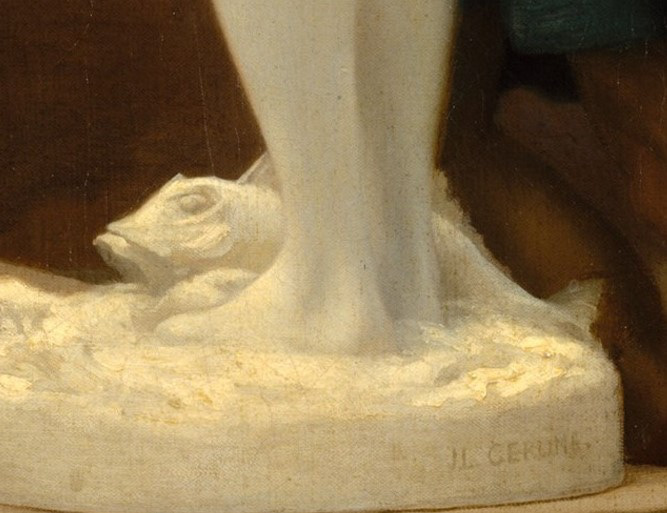


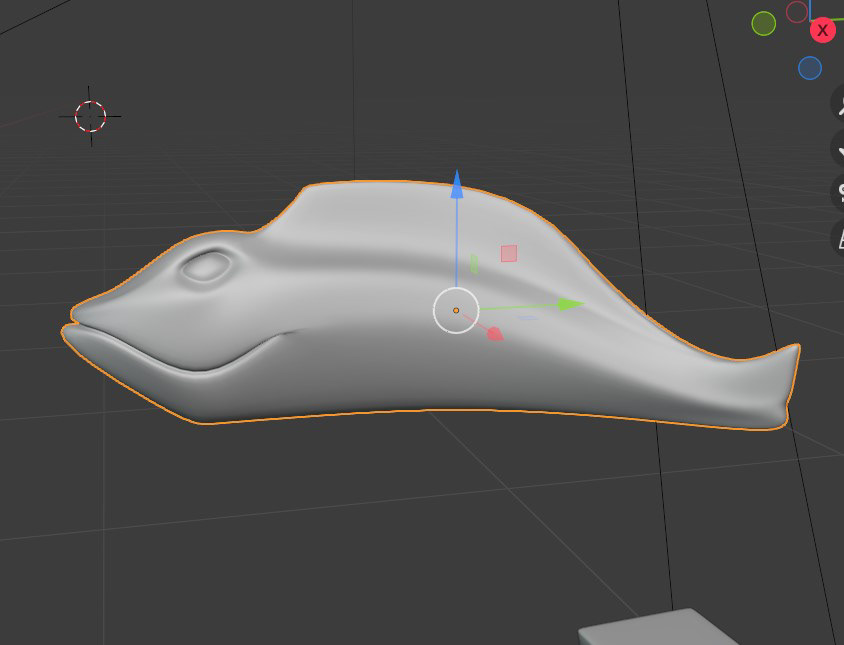

THE CUPID
Not much to say, the cupid is very well known as a symbol of passion and is responsible for making people fall in love once shot by his arrows. The cupid is also the son of Venus, so this may reinforce that the transformation of Galatea is a direct blessing from Venus. Looking at the cupid´s faded appearance, for me it seems that Gerome intentionally didn't give too much attention to the details in this figure since he didn't want the cupid to call much attention. In my reinterpretation I let the original cupid in the scene for the same reason.
THE MASKS
I'm not sure about what it could mean exactly but these masks seem to be related to the symbol of theatre (a happy and a sad face together). I would say that this may be a message saying that the transformation of Galatea into a real being brings not only the pleasures, but also the pains of a relationship with a real human being, with her own thoughts, desires and feelings, and the fact that Pygmalion has these elements in his bench means that he is aware of this reality and embraces all the faces of his true love Galatea. In my reinterpretation I also let the original masks in the scene.




THE “STUDIO”
Well, I don't have a studio, but I have enough lemons to make a reasonable lemonade 😅.
So I tried to set up the lights as similar as possible to resemble the light references used in the painting.




THE MODELS AND THE PHOTO SESSION
To pose like the wonderful Galatea, no one better than my inspiring muse 😊... and to represent a Pygmalion in love, nothing better than her real lover... myself!😋
Looking at the softness and delicacy of Galatea´s posing, we can't imagine how hard it is to stand in that position!😱
And after almost 150 shots adjusting spine curvatures and body twists, we realized how flexible Galatea should be to stand in such acrobatic position! Lucky me, my model is a real Yogi 😎 We´ve made it!



COMPOSITION
Now I have a fully 3D rendered environment and all the photographic resources. Next step is to put it all together, and fine tune the blend between 3D render and 2D Photography. Time for Photo Editing and Digital Painting.



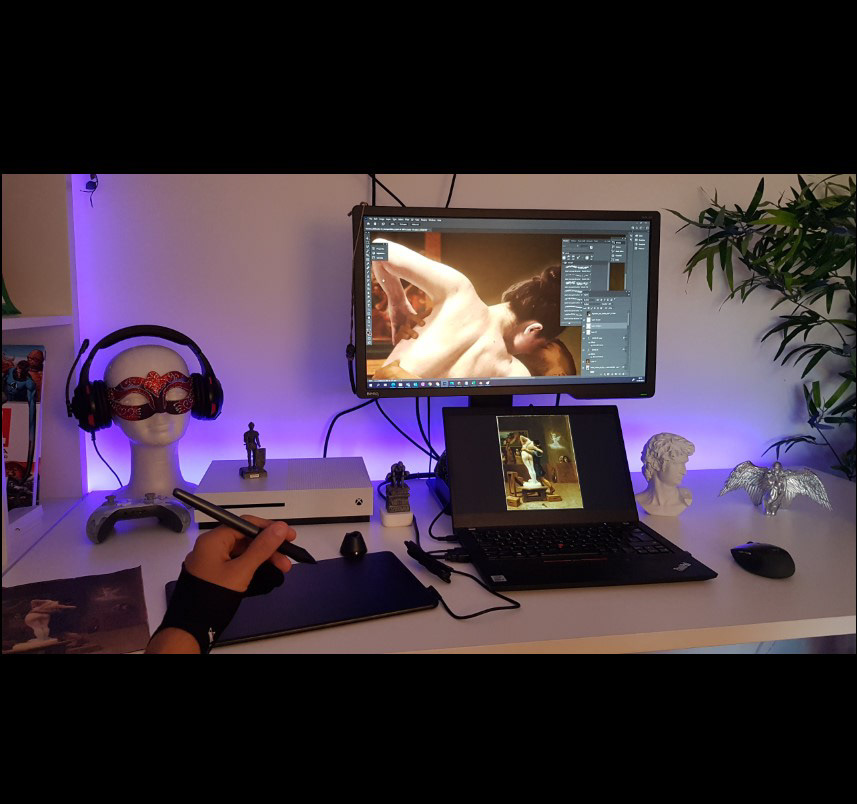

THE FINAL PIECE
After a great journey, this is the final result, my own recreation of Pygmalion & Galatea from Jean-Leon Gerome. I hope you have enjoyed the journey and the final result 🙂.
And by the way, thinking about this delightful adventure, I came to realize why I feel so connected to Pygmalion´s tale: Like him, I once created a sculpture in my mind, about an amazing kind of woman with very specific virtues and mindset. I fell in love with that imaginary sculpture and I could no longer accept that love standards created by the society around me. In fact, most people used to tell me that I was naive, and that kind of woman didn´t exist. However, it was worth believing, and I found not only one, but some of them, Diana´s nymphs, libertarian daughters of Venus, blessed with the power of love and beauty. They are around there, looking for those who are worthy of their delights. And one in particular had all that amazing virtues I was looking for, and much more. Against all odds, and by the mercy of the goddesses, I was found worthy of her. So thank you, mother Aphrodite, for making flesh and blood from the ivory sculpture that once lived only in my mind ❤️.




